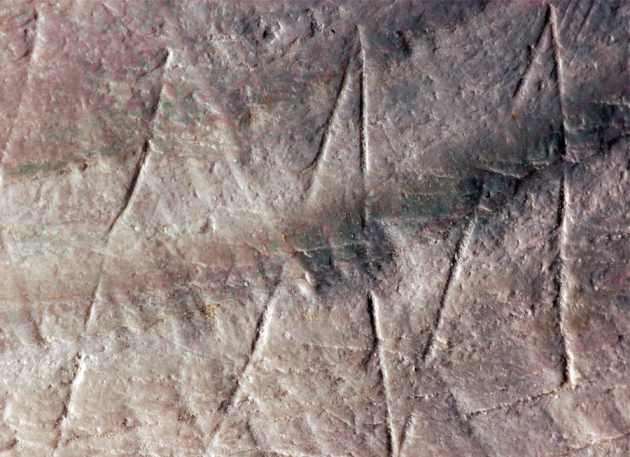
The discovery of what appear to have been deliberately etched markings made by a human ancestor, Homo erectus, on the surface of a shell, call for a reconsideration of assumptions that have been made about the origins of abstract thought.
While the meaning of these zigzag markings will most likely remain forever unknown, it can reasonably be inferred that for the individual who created them, the marks had some significance.
In a report in Nature, Josephine Joordens, a biologist at Leiden University whose team discovered the markings, says:
“We’ve looked at all possibilities, but in the end we are really certain that this must have been made by an agent who did a very deliberate action with a very sharp implement,” says Joordens. Her team tried replicating the pattern on fresh and fossilized shells, “and that made us realize how difficult it really was”, she says.
Saying much more about the engraving is tricky. “If you don’t know the intention of the person who made it, it’s impossible to call it art,” says Joordens.
“But on the other hand, it is an ancient drawing. It is a way of expressing yourself. What was meant by the person who did this, we simply don’t know, ” she adds. “It could have been to impress his girlfriend, or to doodle a bit, or to mark the shell as his own property.”
Clive Finlayson, a zoologist at the Gibraltar Museum who was part of the team that described cross-hatch patterns linked to Neanderthals, is also agnostic about whether to call the H. erectus doodles art. What is more important, he says, is the growing realization that abilities such as abstract thinking, once ascribed to only H. sapiens, were present in other archaic humans, including, now, their ancestors.
“I’ve been suggesting increasingly strongly that a lot of these things that are meant to be modern human we’re finding in other hominids,” he says. “We really need to revisit these concepts and take stock.”
Palaeoanthropology, by necessity, is a highly speculative discipline — therein lies both its strength and its weakness.
The conservatism of hard science recoils at the idea that some scratches on a single shell amount to sufficient evidence to prompt a reconsideration about the origins of the human mind, and yet to refrain from such speculation seems like an effort to restrain the powers of the very thing we are trying to understand.
Rationally, there is as much reason to assume that abstract thinking long predates modern humans and thus searching for evidence of its absence and finding none would leave us agnostic about its presence or absence, than there is reason to assume that at some juncture it was born.
My inclination is to believe that any living creature that has some capacity to construct a neurological representation of their surroundings is by that very capacity employing something akin to abstract thinking.
This ability for the inner to mirror the outer has no doubt evolved, becoming progressively more complex and more deeply abstract, and yet mind, if defined as world-mirroring, seems to have been born when life first moved.

